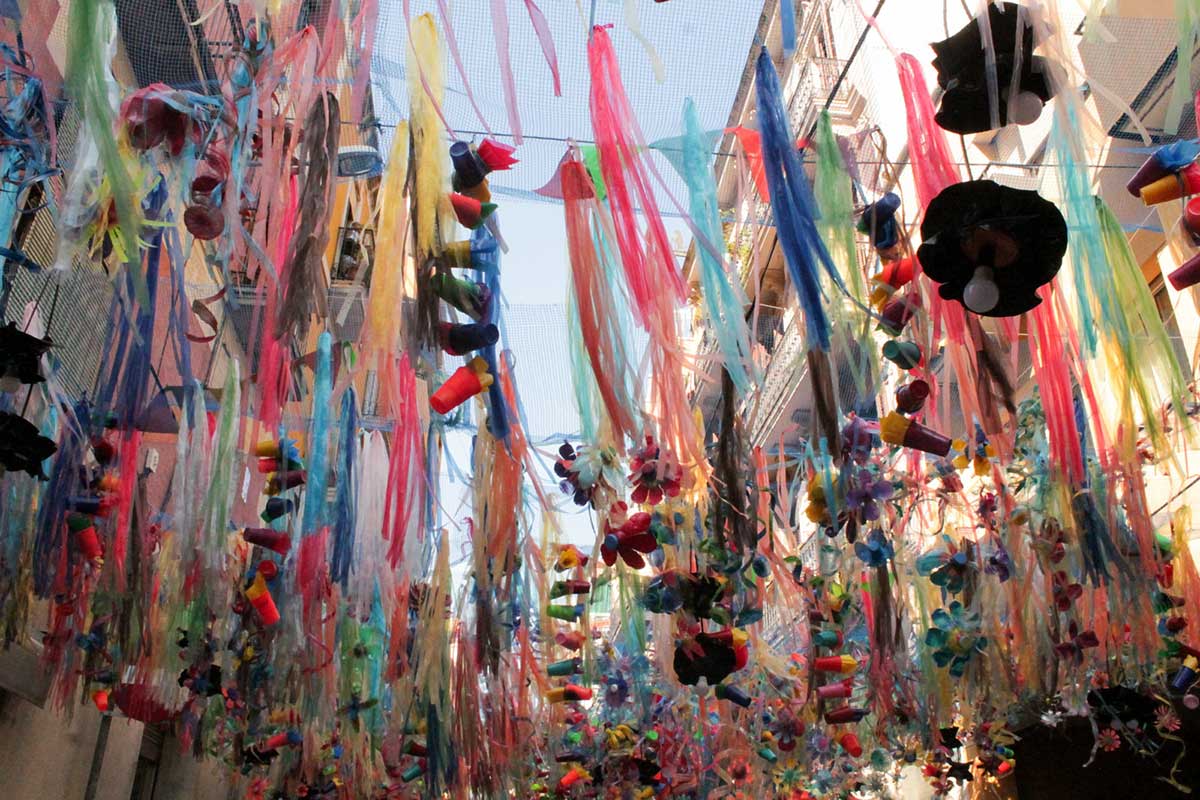The Surreal Streets of Festa Major de Gràcia

The Festa Major de Gràcia in Barcelona, Catalonia, begins on August 15 and continues for a full week of cultural events, street decorations, and late-night intergenerational partying.
August 15 is also my birthday, so it has become somewhat of a tradition for me to attend the celebration.
The festival started in 1817 on the day of the Assumption of Mary, also the fifteenth of August, in honor of Gràcia—an independent town until 1897, when it was annexed by Barcelona. During the nineteenth century, the town started transforming from a rural area to an urban town. Throughout this transition, the town continued the tradition of decorating the streets and squares with varying degrees of participation from locals, depending on the current political and social climate.
Over the past two hundred years, the festival has gone through many changes, notably becoming more of a secular civic celebration with fewer Catholic traditions—a trend among many festivals across Catalonia. Yet it has kept true to its roots of bringing together a community, celebrating the neighborhood, and being free to the public.
Festa Major de Gràcia now attract thousands of locals and tourists from around the world who come to the neighborhood to see the decorated streets and participate in the ongoing cultural activities. The festival includes many traditions, including castells (human towers), theater performances, and concerts on stages that pop up in the decorated streetscapes.

-
The theme of the Plaça de Rovira i Trias was “Fantasia in White.” The whole plaza was draped in a white sea of clouds made from paper, with wire figurines creating ghostly images dancing in the plaza.Photo by Stephanie Echeveste
-
The theme of Carrer Providència was “Flower Power,” with peace signs and flower lamps that lit up at night.Photo by Stephanie Echeveste
-
Street in Gràcia decorated with paper, plastic bottles, wood, and other materials.Photo by Stephanie Echeveste
-
Giant animals made from papier-mâché grace the entrance of Verdi del Mig for the theme of Atmos Feres.Photo by Stephanie Echeveste
-
Detail of giraffe sculpture at Verdi del Mig.Photo by Stephanie Echeveste
-
A church reconstructed in the middle of the street and complete with detailed frescos, also on San Antoni Travessia.Photo by Stephanie Echeveste
-
Ski chalet recreated for the theme of Travesquia on Sant Antoni Travessia, the first-prize winner of 2017’s Festa Major de Gràcia. I enjoyed a glass of wine outside, in the fake snow.Photo by Stephanie Echeveste
-
Carrer Berga transforms into a candy shop with the help of hundreds of hands carefully hand crafting non-edible, larger-than-life sweets.Photo by Stephanie Echeveste
-
A market of handmade produce that will fool a visitor even up close takes over Career Placeta de Sant Miquel.Photo by Stephanie Echeveste
-
Carrer de Francisco Giner honored the origins of the Festa Major de Gracia, with a description of enramades, originally made from vegetables and flowers, and historical photos dating back to 1894.Photo by Stephanie Echeveste
-
More fruits and vegetables at Carrer de Francisco Giner.Photo by Stephanie Echeveste
-
Entrance to the Carrer de Francisco Giner.Photo by Stephanie Echeveste
Click on the image above to view full gallery
But the most impressive part of the festival is the street decor, called engalaments in Catalan. Eighteen streets and squares are decorated by neighborhood associations, each street following a theme and competing for prizes. Last year, one street transformed into a ski chalet, another into a candy shop, and yet another into a colorful market. These decorations, made from mostly recycled goods, transform the tiny, romantic streets into larger-than-life immersive experiences. Together they demonstrate what urban environments can become when local residents come together to create something special.
The street decorations are visually stunning, even mesmerizing up close when you realize how they are made. Those gorgeous flowers? Plastic bottles. That ski lodge wall? Foam board. The giant elephant? Papier-mâché. On each street, neighbors create these scenes by working side by side with artisans from a range of occupations—from florists and carpenters to IT specialists. Everyone takes part.
My aunt, Diana Trujillo, remembers seeing the team that put together the ski chalet theme street: “They were all in their matching team shirts, enjoying food and drinks together on the last day. There was such camaraderie among them.”
Festa Major de Gràcia is a unique tradition that gives visitors a glimpse into local life and civic collaboration through amazing food, history, and culture. And of course, drinking and dancing in the plazas with folks of all ages, all night long.
For the 2018 Folklife Festival featuring Catalonia, the curatorial team is working with community members from the Gràcia neighborhood to display engalaments on the National Mall. Mark your calendars for June 27 to July 1 and July 4 to 8, 2018.
Stephanie Echeveste is a creative placemaking consultant and founder of Distill Creative. In the past, she has led cocktails + craft workshops at the Folklife Festival Marketplace. She is obsessed with retail storefronts and public spaces, and finds herself traveling often to find them.













